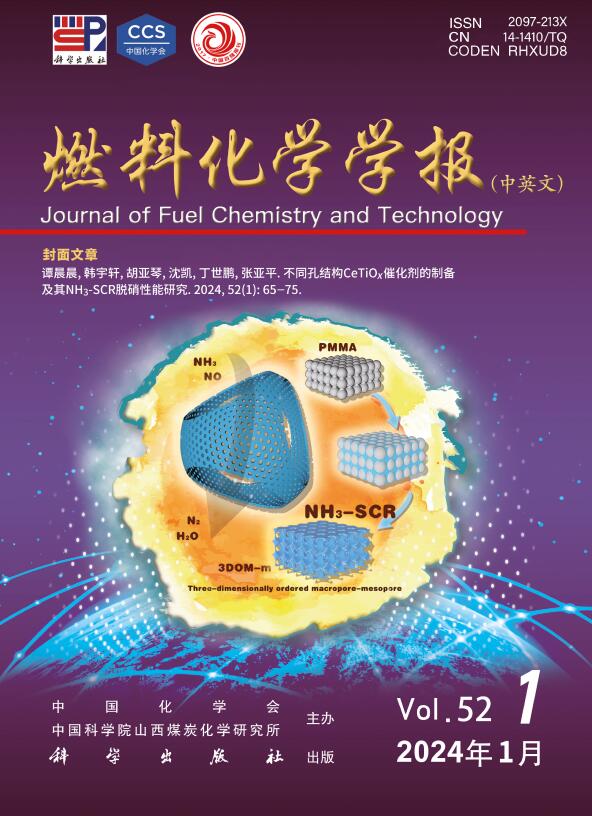Synergistic effect of CaO/HZSM-5 composite catalyst in regulating co-pyrolysis products of rice straw and PVC
Q3 Energy
引用次数: 0
Abstract
Co-pyrolysis of biomass and waste plastics is one of the potential technologies to achieve the resourceful utilization of both, not only to prepare high value-added hydrocarbon-rich bio-oil, but also to achieve clean resourceful utilization of wastes and reduce environmental pollution. However, the products complexity limits its further application of co-pyrolysis technology. In this study, rice straw (RS), an agricultural waste, and polyvinyl chloride plastic (PVC) were used to investigate the individual and co-pyrolysis characteristics of them by thermogravimetric-mass spectrometry (TG-MS) and pyrolysis-gas chromatography/mass spectrometry (Py-GC/MS), and the synergistic regulation law of the pyrolysis products by CaO and HZSM-5 composite catalyst. The results show that interactions exist between PVC and RS during the co-pyrolysis process, which promotes the production of aromatic compounds. The relative content of hydrocarbon compounds in tar is as high as 66.78%. The relative content of aromatics reaches 64.17%. Compared with RS pyrolysis, content of oxygenated compounds in the co-pyrolysis tar fraction decreases by 62.05%, which effectively improves oxidative stability of the tar. CaO/HZSM-5 composite catalyst shows better light aromatic selectivity compared with the individual one. The relative content of C4–C10 hydrocarbons in the pyrolysis tar increases by 2.81% and 5.06%, respectively. Under the synergistic effect of CaO/HZSM-5 composite catalyst, relative content of monocyclic aromatic hydrocarbons in the tar is 34.34%, which is larger than the theoretical calculated value of 33.03%. And relative content of PAHs is 28.21%, which is smaller than the theoretical value of 31.22%. In addition, the CaO/HZSM-5 composite catalyst promotes immobilisation of Cl in the form of chlorides such as CaCl2 in the char, which significantly reduces the gas-phase release of elemental Cl.
CaO/HZSM-5复合催化剂对稻草与PVC共热解产物的协同调节作用
生物质与废塑料共热解是实现两者资源化利用的潜在技术之一,不仅可以制备高附加值的富烃生物油,而且可以实现废弃物的清洁资源化利用,减少环境污染。但产物的复杂性限制了共热解技术的进一步应用。本研究以水稻秸秆(RS)、农业废弃物和聚氯乙烯塑料(PVC)为研究对象,采用热重质谱法(TG-MS)和热解气相色谱质谱法(Py-GC/MS)研究了它们的单质和共热解特性,并研究了CaO和HZSM-5复合催化剂对热解产物的协同调节规律。结果表明,在共热解过程中,PVC和RS之间存在相互作用,促进了芳香族化合物的生成。焦油中烃类化合物的相对含量高达66.78%。芳烃相对含量达64.17%。与RS热解相比,共热解焦油馏分中含氧化合物含量降低了62.05%,有效提高了焦油的氧化稳定性。CaO/HZSM-5复合催化剂比单个催化剂具有更好的光芳选择性。热解焦油中c4 ~ c10烃的相对含量分别提高了2.81%和5.06%。在CaO/HZSM-5复合催化剂的协同作用下,焦油中单环芳烃的相对含量为34.34%,大于理论计算值33.03%。多环芳烃的相对含量为28.21%,小于理论值31.22%。此外,CaO/HZSM-5复合催化剂促进Cl在炭中以氯化物(如CaCl2)的形式固定,这显著减少了单质Cl的气相释放。
本文章由计算机程序翻译,如有差异,请以英文原文为准。
求助全文
约1分钟内获得全文
求助全文
来源期刊

燃料化学学报
Chemical Engineering-Chemical Engineering (all)
CiteScore
2.80
自引率
0.00%
发文量
5825
期刊介绍:
Journal of Fuel Chemistry and Technology (Ranliao Huaxue Xuebao) is a Chinese Academy of Sciences(CAS) journal started in 1956, sponsored by the Chinese Chemical Society and the Institute of Coal Chemistry, Chinese Academy of Sciences(CAS). The journal is published bimonthly by Science Press in China and widely distributed in about 20 countries. Journal of Fuel Chemistry and Technology publishes reports of both basic and applied research in the chemistry and chemical engineering of many energy sources, including that involved in the nature, processing and utilization of coal, petroleum, oil shale, natural gas, biomass and synfuels, as well as related subjects of increasing interest such as C1 chemistry, pollutions control and new catalytic materials. Types of publications include original research articles, short communications, research notes and reviews. Both domestic and international contributors are welcome. Manuscripts written in Chinese or English will be accepted. Additional English titles, abstracts and key words should be included in Chinese manuscripts. All manuscripts are subject to critical review by the editorial committee, which is composed of about 10 foreign and 50 Chinese experts in fuel science. Journal of Fuel Chemistry and Technology has been a source of primary research work in fuel chemistry as a Chinese core scientific periodical.
 求助内容:
求助内容: 应助结果提醒方式:
应助结果提醒方式:


